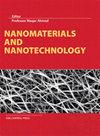Tunable formation of copper metal, oxide, chloride and hydroxyl chloride nanoparticles from aqueous copper solutions using nanoscale zerovalent iron particles
IF 3.3
3区 材料科学
Q2 MATERIALS SCIENCE, MULTIDISCIPLINARY
引用次数: 8
Abstract
The influence of different parameters (solid–liquid ratio, initial pH, initial Cu concentration and anion type) on the cementation of aqueous copper (Cu) with nanoscale zerovalent iron (nZVI) has been studied. The work has been established to study both the influence such parameters have on the kinetics and efficacy of the cementation process but also the physicochemical composition of resultant Cu-bearing products. The nZVI exhibited high Cu removal capacity (maximum removal 905.2 mg/g) due to its high surface area. X-ray diffraction determined the most common Cu-bearing precipitates were Cu2O, CuCl2 and Cu2(OH)3Cl for solutions containing Cl− counterions (CuCl2 salt precursor), while Cu0 and Cu2O were the most common phases for those containing SO 4 2 − counterions (CuSO4 salt precursor). Transmission electron microscopy determined such precipitates were discrete nanoparticles of relatively high purity Cu (e.g. >80 wt% Cu or ≥99.9 wt% Cu and O). Overall the results demonstrate nZVI as effective for the one-pot transformation of aqueous Cu into a range of different high purity Cu-bearing nanoparticles. The methodology developed herein is therefore likely to have important application in the recovery of Cu from wastewater and process solutions where the direct upcycling to high-value Cu-bearing nanoparticles is an advantageous form in which to recover Cu.利用纳米级零价铁颗粒从铜水溶液中可调地形成金属铜、氧化物、氯化物和羟基氯化物纳米颗粒
研究了不同参数(固液比、初始pH、初始Cu浓度和阴离子类型)对水铜(Cu)与纳米级零价铁(nZVI)胶结的影响。研究这些参数对胶结过程动力学和效果的影响,以及所得含铜产物的物理化学组成。nZVI具有较高的比表面积,具有较高的Cu去除率(最大去除率905.2 mg/g)。x射线衍射测定了含Cl−反离子(CuCl2盐前驱体)溶液中最常见的含cu相为Cu2O、CuCl2和Cu2(OH)3Cl,而含so4 2−反离子(CuSO4盐前驱体)溶液中最常见的含cu相为Cu0和Cu2O。透射电子显微镜测定这些沉淀是相对高纯度Cu的离散纳米颗粒(例如,> - 80 wt% Cu或≥99.9 wt% Cu和O)。总体而言,结果表明nZVI可以有效地将水中Cu一锅转化为一系列不同的高纯度含Cu纳米颗粒。因此,本文开发的方法可能在从废水和工艺溶液中回收铜方面具有重要应用,其中直接升级回收高价值含铜纳米颗粒是回收铜的有利形式。
本文章由计算机程序翻译,如有差异,请以英文原文为准。
求助全文
约1分钟内获得全文
求助全文
来源期刊

Nanomaterials and Nanotechnology
NANOSCIENCE & NANOTECHNOLOGY-MATERIALS SCIENCE, MULTIDISCIPLINARY
CiteScore
7.20
自引率
21.60%
发文量
13
审稿时长
15 weeks
期刊介绍:
Nanomaterials and Nanotechnology is a JCR ranked, peer-reviewed open access journal addressed to a cross-disciplinary readership including scientists, researchers and professionals in both academia and industry with an interest in nanoscience and nanotechnology. The scope comprises (but is not limited to) the fundamental aspects and applications of nanoscience and nanotechnology
 求助内容:
求助内容: 应助结果提醒方式:
应助结果提醒方式:


